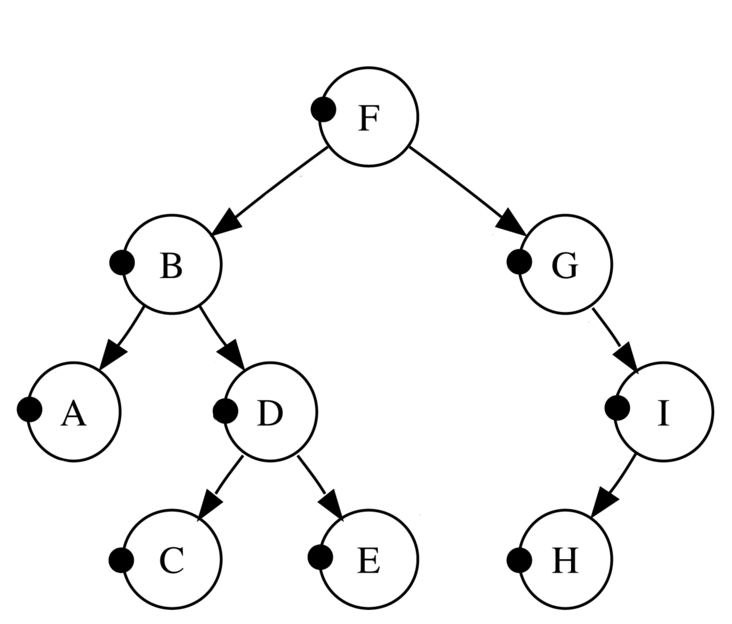二叉树相关 - js描述
小磊 -起因
二叉树几乎是面试过程中必问的知识点,大多数描述过程都是通过C、C++、JAVA、python等语言实现,这里用js语言实现下一下类似的功能,前端、nodejs方向和全栈方向的同学可以作为参考。
示例以下所有实现都是基于以下二叉树示例:
如图所示,建立过程使用binarytree这个库,代码如下:
const BinaryTree = require('binarytree');
let binaryTree = new BinaryTree('F');
let bNode = binaryTree.insert('B', 'left', binaryTree.root);
let aNode = binaryTree.insert('A', 'left', bNode);
let dNode = binaryTree.insert('D', 'right', bNode);
let cNode = binaryTree.insert('C', 'left', dNode);
let eNode = binaryTree.insert('E', 'right', dNode);
let gNode = binaryTree.insert('G', 'right', binaryTree.root);
let iNode = binaryTree.insert('I', 'right', gNode);
let hNode = binaryTree.insert('H', 'left', iNode);深度遍历有前序、中序以及后序三种遍历方法,递归方法非常易懂,代码如下:
前序遍历:根结点 ---> 左子树 ---> 右子树function preorderDFS(root) {
const nodeList = [];
preorder(root, nodeList)
return nodeList;
function preorder(root, nodeList) {
if (root !== null) {
nodeList.push(root.data)
preorder(root.left, nodeList);
preorder(root.right, nodeList);
}
}
}function inorderDFS(root) {
const nodeList = [];
inorder(root, nodeList);
return nodeList;
function inorder(root, nodeList) {
if (root !== null) {
inorder(root.left, nodeList);
nodeList.push(root.data);
inorder(root.right, nodeList);
}
}
}function postorderDFS(root) {
const nodeList = [];
postorder(root, nodeList);
return nodeList;
function postorder(root, nodeList) {
if (root !== null) {
postorder(root.left, nodeList);
postorder(root.right, nodeList);
nodeList.push(root.data)
}
}
}按层次遍历就可以,需要一个队列,根节点先加入队列。队列执行出队操作,出队元素有左孩子入队,没有则不管,有右孩子入队,没有则不管。然后继续以上操作,直到队列为空。
function BFS(root) {
const q = [root];
const nodeList = [];
while (q.length > 0) {
const node = q.pop();
nodeList.push(node.data);
if (node.left !== null) q.unshift(node.left);
if (node.right !== null) q.unshift(node.right);
}
return nodeList;
}打印顺序如图所示:
类似BFS,但是又不同,可以用BFS的思维去思考。
前一层先打印的节点其孩子在下一层后打印,按照这个思路那么其孩子节点需要用栈进行存储。
前后两层,左右孩子的打印顺序是相反的,因此我们需要两个盏实现,一个盏存储奇数层节点入栈顺序为先左孩子后右孩子,另一个盏存储偶数层节点入盏顺序为先右孩子后左孩子。
假设lrStack存储奇数层节点,rlStack存储偶数层节点:
按照思路,代码如下:
function printBintryTree(root) {
const lrStack = [];
const rlStack = [];
lrStack.push(root);
while(lrStack.length > 0 || rlStack.length > 0) {
if (lrStack.length > 0 && rlStack.length === 0) {
while (lrStack.length > 0) {
const tNode = lrStack.pop();
console.log(tNode.data);
if (tNode.right !== null) {
rlStack.push(tNode.right);
}
if (tNode.left !== null) {
rlStack.push(tNode.left);
}
}
}
if (rlStack.length > 0 && lrStack.length === 0) {
while (rlStack.length > 0) {
const tNode = rlStack.pop();
console.log(tNode.data);
if (tNode.left !== null) {
lrStack.push(tNode.left);
}
if (tNode.right !== null) {
lrStack.push(tNode.right);
}
}
}
}
}// 蛇形打印
printBintryTree(binaryTree.root); // F B G I D A C E H
// 广度遍历
console.log(BFS(binaryTree.root)); // ['F', 'B', 'G', 'A', 'D', 'I', 'C', 'E', 'H']
// 深度遍历
console.log(preorderDFS(binaryTree.root)); // ['F', 'B', 'A', 'D', 'C', 'E', 'G', 'I', 'H']
console.log(inorderDFS(binaryTree.root)); // ['A', 'B', 'C', 'D', 'E', 'F', 'G', 'H', 'I']
console.log(postorderDFS(binaryTree.root)); // ['A', 'C', 'E', 'D', 'B', 'H', 'I', 'G', 'F']; 特别申明:本文内容来源网络,版权归原作者所有,如有侵权请立即与我们联系(cy198701067573@163.com),我们将及时处理。
上一篇: 前端面试每日 3+1 —— 第830天
下一篇: 前端面试每日 3+1 —— 第829天
Tags 标签
javascriptnode.jsChrome二叉树前端扩展阅读
谷歌上网助手GHelper – Chrome插件下载(谷歌浏览器插件)
2020-03-12 14:10:44 []CSGO电竞API数据接口【West S2战队数据】分享使用演示
2020-09-03 07:18:05 []wamp配置局域网访问
2020-09-04 01:12:17 []接口测试工具apipost3.0版本对于流程测试和引用参数变量
2020-09-15 15:12:13 []vs code的使用与常用插件和技巧大全总结
2020-09-17 03:07:47 []没有伞的孩子 [必须] 要学会奔跑
2020-09-17 04:49:49 []学习之apipost3.0文档移动和文档管理教程
2020-09-18 06:19:35 []分享—如何使用apipost模拟手机实现请求发送
2020-09-18 12:15:00 []【分享】apipost如何使用mock测试
2020-09-19 21:59:25 []Apipost使用技巧之分享
2020-09-19 11:44:49 []加个好友,技术交流

